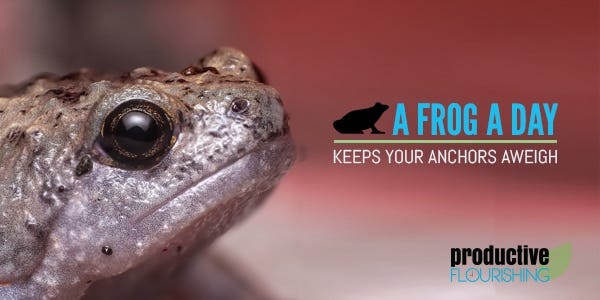A Frog a Day Keeps Your Anchors Aweigh
If you know you have to swallow a frog, swallow it first thing in the morning
It's amazing how some of the smallest of tasks can take on a life of their own. Of course, the truth of it is that they don't take on a life of their own — we are the ones that give them their vitality.
It could be something as simple as paying a bill, even though we have the money to pay. Or it could be responding to an email that might take 3 minutes to do if we'd just make up our mind and do it.
I've written about these types of things before — I call them frogs based on a quote from Mark Twain:
If you know you have to swallow a frog, swallow it first thing in the morning. If there are two frogs, swallow the big one first.
Someone recently commented that she didn't much care for the violent, destructive nature of the metaphor, and I can see her perspective. So let's change it up a bit: if you know you have to catch a frog, do it first thing in the morning; if there are two frogs, catch the big one first.
The reason to catch it first thing in the morning is so that you avoid increasing the dread-to-work ratio.
The Dread-to-Work Ratio, Explained
Most tasks generally require a fixed minimum amount of work — meaning that doing them later won't make them any easier. If a task was going to take 5 minutes at first, then odds are, it's going to take at least 5 minutes whenever you do it. The "work" part of the equation stays the same.
It's the "dread" that increases substantially with time. The longer the task sits there, the more you think about it, and the amount of time you've invested in thinking about and putting off the task somehow gets added to the psychological "size" of the task. The frog gets bigger and wartier, and the warts themselves start growing hairs and warts. It feels that way, at least.
At a certain point, the distinction between directly working on that task and indirectly working on it blurs to the point at which it doesn't make sense to make the distinction. If you've spent all day (or week) avoiding and fretting about the task, then you've spent time and energy on it that you could have spent on other things. To think about it in terms of the "soft costs" of inaction belies the point that it's still costly.
A Frog a Day Keeps Your Anchors Aweigh
My prior suggestion to catch the frog first thing in the morning is not quite fine-grained enough, to be honest. Just as with time, not all frogs are the same. A frog that requires a creative solution to catch needs to be chased during creative times. When a bunch of little frogs can be caught at the same time, they should be batched and caught together. But be honest with yourself about whether you're putting off catching your frogs because you have a more effective plan or because you really don't want to catch them.
I often advise my clients to identify their frogs and catch at least one a day (if they have any — which we all do). When clients do this, three interrelated things happen: 1) the dread-to-work ratio stays pretty low, 2) they get fewer and smaller frogs, and 3) they're able to build some pretty serious momentum with their products. These results are a bit counterintuitive, so I'll explain what's going on.
Because people identify the frogs early on, acknowledge them for what they are, and catch them sooner rather than later, the dread-to-work ratio stays as low as possible. Because they start thinking about the nature of their frogs, they see trends and patterns in their workflow; once they see those trends and patterns, they can start working on eliminating the parts of their lives that are generating the frogs in the first place. Lastly, because they're releasing a lot of negative energy and doing fewer of the things they'd rather not, they can spend that time and energy on the things they actually want to do.
But I should be clear here: there will always be frogs. They may be smaller... they may come up less often... and they may be an entirely new type of frog, but they'll pop up nonetheless. Spot ’em, catch ’em, and move on to the next thing — there's no need to increase the work by dreading it so much.
What frog is staring you down right now? Is it really that big, or can you take care of it today?



